15 Most Common Types of Butterflies in Wisconsin
-
Cassandra Kyser
- Last updated:
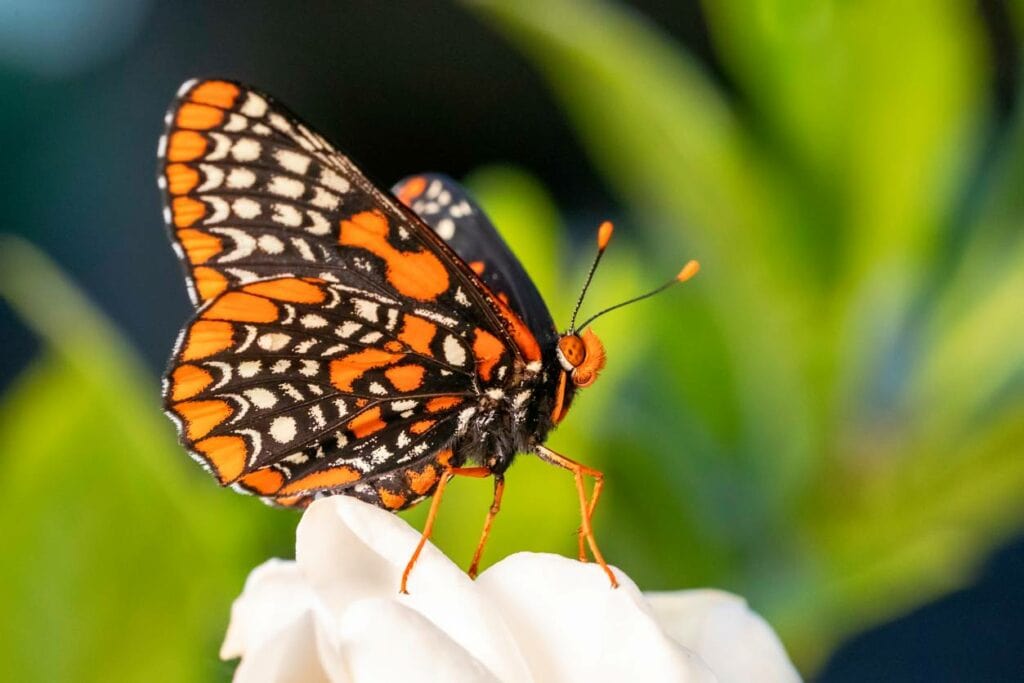
You may associate butterflies with summer, but many species are active in Wisconsin from early spring through fall. Our list covers 15 of the most common butterflies you can see in the state. Some are easy to spot, while others will prove a challenge for novice butterfly watchers. Find out when the best time to watch for each species is, their host plants, and where you can see them.

The 15 Most Common Butterflies of Wisconsin
1. Monarch
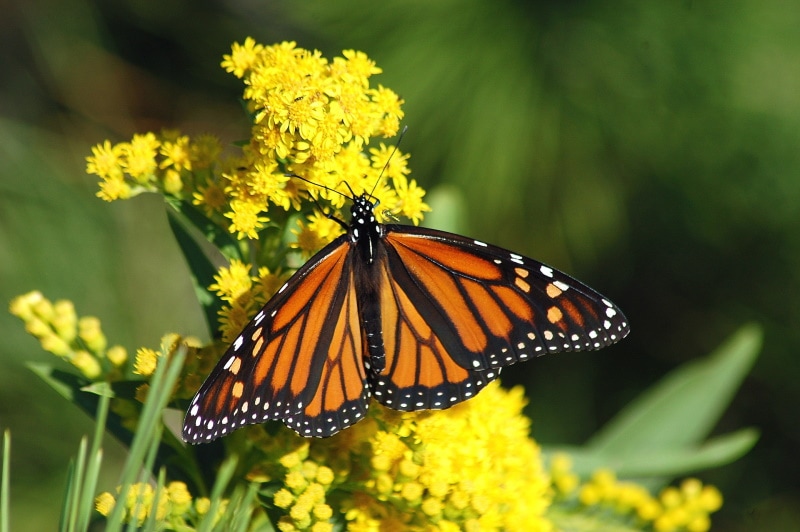
| Scientific name | Danaus plexippus |
| Host plant | Milkweed |
Monarchs are one of the easiest-to-spot butterflies on our list. Their vibrant orange and black coloring makes them easy to spot, even from a distance. While the monarchs only lay eggs on milkweed, adults feed on many flowers. You can see monarchs throughout the summer months in Wisconsin. When the weather turns cold, they travel thousands of miles to migrate to California and New Mexico, where they spend the winter.
Monarchs in Wisconsin have a unique lifecycle. Butterflies hatched during the summer only live a few weeks. The last brood to hatch delays sexual maturity during migration. While their population has declined considerably since the 1990s, you can still see them in every county.
2. Red-Spotted Purple

| Scientific name | Limenitis arthemis astyanax |
| Host plants | Willow, poplar, cherry, birch |
Your best chance of seeing a red-spotted purple butterfly is in the southern half of the state along the Illinois border. These butterflies have two broods per summer, from May to July and then July to August. The second brood spends the winter in their chrysalises. Historically, most Wisconsin sightings occur at the beginning of June and the beginning of August. You are likelier to see a red-spotted purple in a ditch than in a garden. Adults feed on scat, tree sap, rotting fruit, and carrion.
3. Dreamy Duskywing

| Scientific name | Erynnis icelus |
| Host plants | Mostly willows and poplars, occasionally aspens and birch |
Your best chance of seeing a dreamy duskywing in Wisconsin is around Memorial Day weekend, from the last week of May to the first week of June. These butterflies stick close to the edges of woodlands, where they feed on wild berries. Historically, sightings are concentrated in the northern half of the state. These butterflies have one brood from April to early July. Adult dreamy duskywings spend the harsh winters protected in leaf shelters.
4. Mourning Cloak
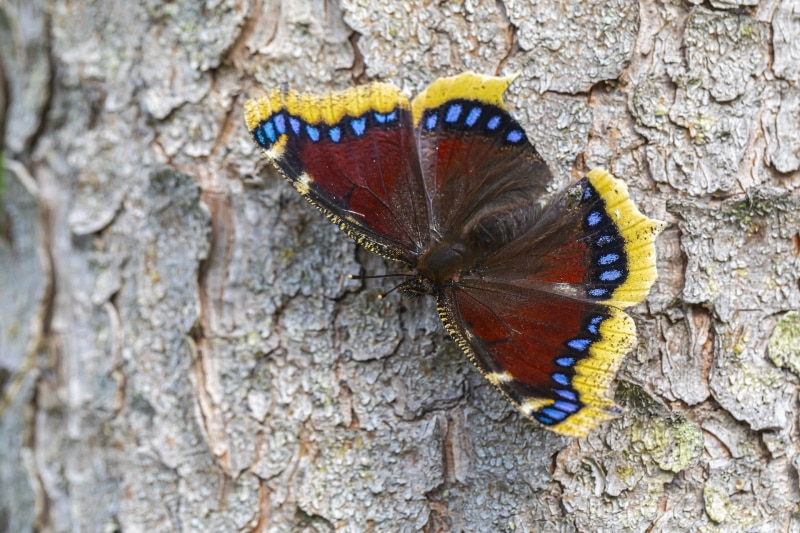
| Scientific name | Nymphalis antiopa |
| Host plants | Elm, hackberry, willow, and cottonwood |
Mourning cloaks are often the first butterfly you see in the spring in Wisconsin, as they appear as early as March. You find them deep in the woods or near the edges of woodlands. Adults eat tree sap and rotting fruit. Sightings typically peak at the end of June, but under the right conditions, you could see one as late as November.
Mourning cloaks have a relatively long lifespan of 10 months. You’ll notice that a mourning cloak’s colors fade as the summer progresses into fall. These butterflies stay in Wisconsin and hibernate during the winter.
5. Viceroy
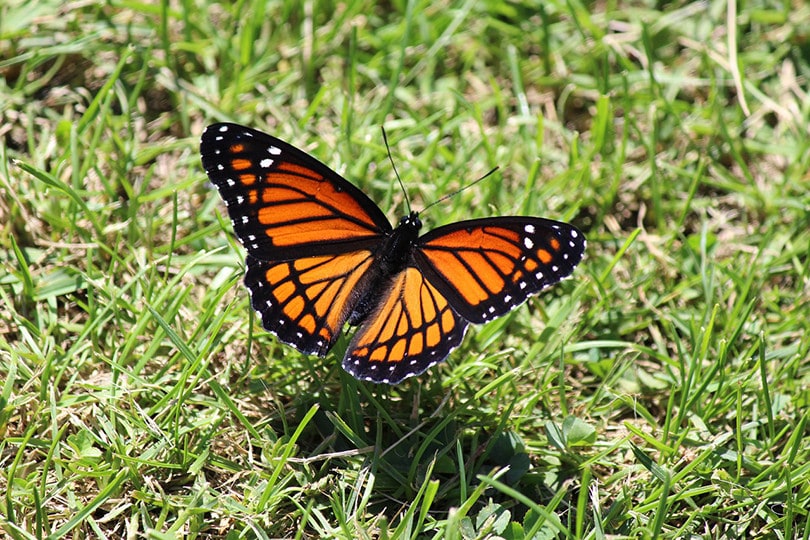
| Scientific name | Limenitis archippus |
| Host | Willows |
At first glance, it’s easy to confuse a viceroy with a Monarch. Viceroys are slightly smaller and have a horizontal stripe across their back wings. They have two broods each year, late May through July and then late July into September.
Your best chance of seeing a viceroy in Wisconsin is near wetlands. Adults feed on dung, carrion, fungi, golden rod, and thistles. These butterflies are in abundance in late July and early August. However, they are present from mid-May through the beginning of October.
6. Coral Hairstreak
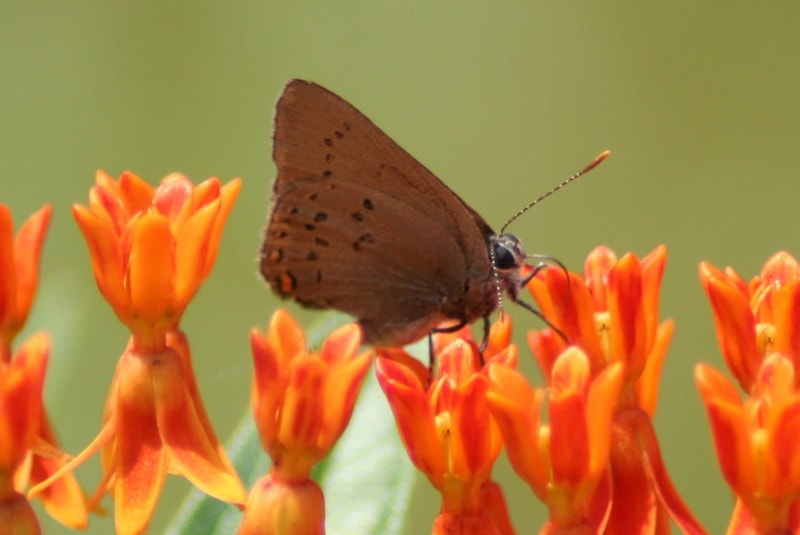
| Scientific name | Satyrium titus |
| Host plants | Wild cherry and plum |
Coral hairstreaks have a scattered presence throughout the state. Historically, most sightings occur in the south-central counties and along the Minnesota and Great Lakes borders. You only have a short time to spot a Coral hairstreak in Wisconsin, as they’re typically only seen in June and July.
These butterflies can be seen in several settings, including shrubby areas, along roadsides, and woodland openings. Adults feed on butterfly weed, dogbane, and sulphur flowers. The Coral Hairstreak looks similar to an Acadian hairstreak but lacks a tail.
7. Clouded Sulphur

| Scientific name | Colias philodice |
| Host plants | Hay, alfalfa, and clover |
Butterfly watching isn’t limited to the spring and summer months in Wisconsin. The clouded sulphur is one of the last butterflies you’ll see in the fall. These butterflies have three broods per season in Wisconsin, stretching from April through November.
They tend to congregate in large numbers in hay fields. Clouded sulphurs have been known to hybridize with similar-looking orange sulphurs. This butterfly should not be confused with the similarly-named cloudless sulphur.
8. Cabbage White

| Scientific name | Pieris rapae |
| Host plants | Mustard plants |
For all its striking white and black beauty, the Cabbage white is an invasive species not native to North America. It spread through trade in the 1800s, from Asia to Europe and eventually to the United States. In the U.S., host plants and food are one and the same for Cabbage whites.
Their favorite snacks include broccoli, cabbage, and turnips. Cabbage whites are often seen in large numbers feeding. They have a long presence in the state, from March through November. Sightings historically peak at the end of July and early August. Cabbage whites can have up to three broods a season. They stay in Wisconsin during the winter, where they overwinter as chrysalises.
9. Aphrodite Fritillary

| Scientific name | Speyeria aphrodite |
| Host plants | Violets |
Aphrodite fritillaries pose a challenge for novice butterfly watchers in Wisconsin. They’re difficult to distinguish between the great spangled fritillary in the state’s south and the Atlantis fritillary in the north.
They have one brood per season, and aphrodite spottings occur from the beginning of June through the beginning of September, peaking at the start of July. Adults congregate in fields and woodland edges, feeding on viper’s bugloss and milkweed. Aphrodite fritillaries spend the winter here as caterpillars.
10. Silvery Blue

| Scientific name | Glaucopsyche lygdamus |
| Host plants | Milkvetch and lotus |
Silvery blues are one of the first butterflies you can see in Wisconsin. You only have a limited time to watch for them in Wisconsin, from late April through the first week in June. Sightings peak during the last two weeks of May. These butterflies have a single brood, and your best chance of seeing a silvery blue is in an open wooded area, where they fly close to the ground. Adults feed on lupine blossoms.
11. Summer Azure
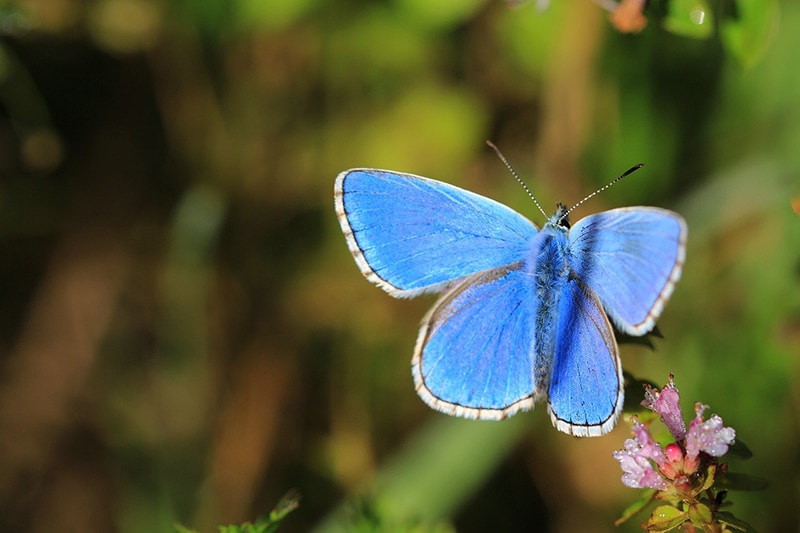
| Scientific name | Celastrina ladon neglecta |
| Host plants | Black cherry and sumac |
Summer azures have a steady presence from June through August. Sightings taper off at the beginning of September, and the butterflies have two broods each summer. Summer azures are common throughout the entire state. The ideal places to watch for these butterflies are forests and woodland edges. They have been known to frequent urban parks, as well. Summer azures look similar but are lighter colored than their close relative, the spring azure.
12. Eastern Tiger Swallowtail
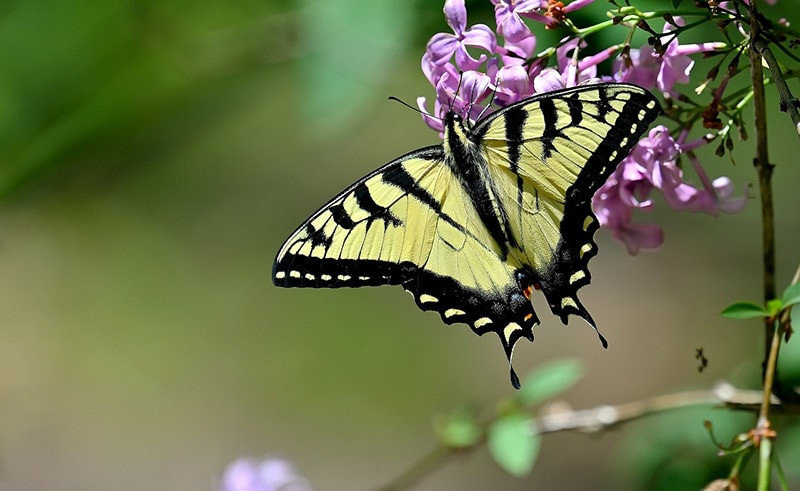
| Scientific name | Papilio glaucus |
| Host plants | Several woody plants |
Eastern tiger swallowtails are present in the southern part of Wisconsin. Their close relative, the Canadian tiger swallowtail, is found in the northern half. These butterflies have two broods each year. You can watch for eastern tiger swallowtails from April through September, with sightings peaking at the end of July and early August. These butterflies frequent wooded areas where they feed on several flowers, including milkweed, lilac, phlox, and wild cherry.
13. Edwards’ Hairstreak
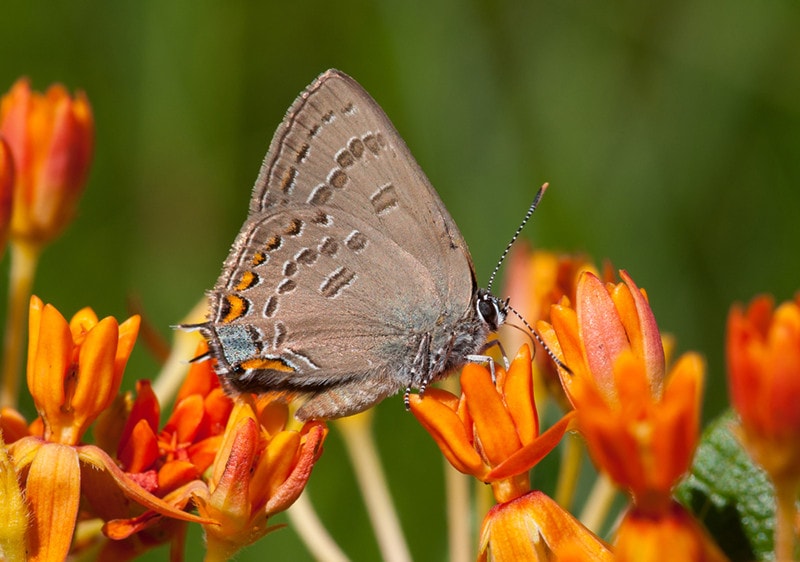
| Scientific name | Satyrium edwardsii |
| Host plant | Oaks |
Edwards’ hairstreaks only have one brood in Wisconsin, so you have a narrow window of time to see them. Sightings generally only occur in July. You can find these butterflies anywhere there are oak trees. Adult Edwards’ hairstreaks feed on milkweed plants. They do not congregate in large numbers, but you may see two or three in one area when feeding. Edwards’ hairstreaks look similar to and are often confused with banded hairstreaks.
14. Hackberry Emperor
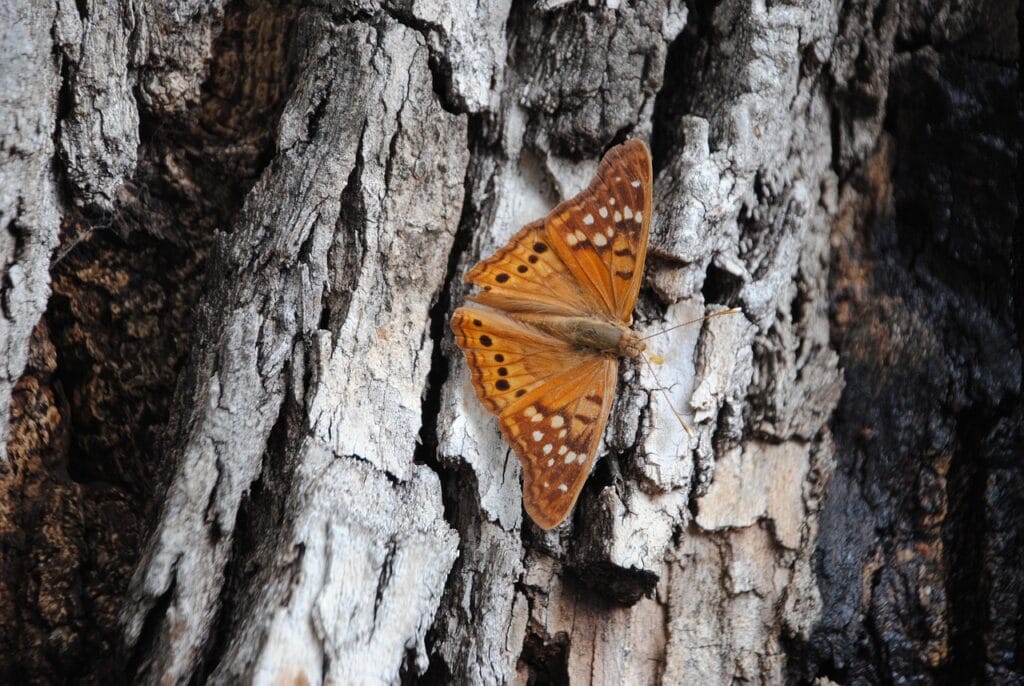
| Scientific name | Asterocampa celtis |
| Host plant | Hackberry tree |
The hackberry emperor takes its name from its host plant, the hackberry tree. These butterflies are seen in the southern half of Wisconsin, as hackberry trees typically do not grow in the northern half. You can spot hackberry emperors anywhere their host plant grows. Sightings of the butterflies occur from June through September, with peaks at the end of June and August. The Hackberry emperors found in the state have color variations ranging from gray to orange-brown.
15. Tawny Emperor

| Scientific name | Asterocampa clyton |
| Host plant | Hackberry tree |
Tawny emperors live in the southern half of Wisconsin, where hackberry trees are abundant. These butterflies share territory with Hackberry emperors but in fewer numbers. Tawny emperors have one brood each summer. Sightings of this butterfly peak around the 4th of July. You won’t find adults near flowers, as they feed on dung, carrion, rotting fruit, and tree sap. Look for Tawny emperors near roadsides, fruit trees, and wooded areas. These butterflies often fly low to the ground.
Wisconsin Butterflies FAQs
Where Do Butterflies Go During the Winter in Wisconsin?
Butterflies can’t survive Wisconsin winters due to the sub-zero temperatures and lack of food. Some species on our list spend the winter wrapped up as chrysalises, while others burrow as caterpillars in leaf shelters. Butterfly migration is the exception since only monarchs fly to warmer states.

Where Is the Best Place To See Wisconsin Butterflies?
Find a butterfly’s host plant or adult food source if you want to see a specific species. Several butterflies on our list eat or lay their eggs on milkweed. Other popular spots for butterflies are woodland edges and roadsides.
What Is the Most Common Butterfly in Wisconsin?
Statewide it’s easy to spot a monarch during the summer. Mourning cloaks and cabbage whites have a spring-to-fall presence in the state. The abundance of any species can vary from year to year based on the availability of host plants and adult food.

Conclusion
Wisconsin is home to a vast array of beautiful butterflies. Our list contains 15 of the most common ones you can see in the state. Some species, like the monarch, can be seen throughout the state. Others, like the tawny emperor and hackberry emperor, have historically been spotted in the southern counties. Wherever you live in Wisconsin, there are opportunities to watch for butterflies.
- https://www.nwf.org/Educational-Resources/Wildlife-Guide/Invertebrates/Monarch-Butterfly
- https://www.fs.usda.gov/wildflowers/pollinators/Monarch_Butterfly/habitat/index.shtml
- https://wisconsinbutterflies.org/
- https://uwm.edu/field-station/red-spotted-purple/
- https://www.butterfliesandmoths.org/species/Erynnis-icelus
- https://nhpbs.org/wild/mourningcloak.asp
- https://nhpbs.org/wild/viceroy.asp
- https://www.birdsandblooms.com/gardening/attracting-butterflies/clouded-sulphur-butterfly-garden/
- https://www.sciencedaily.com/releases/2019/09/190910194251.htm
- https://www.butterfliesandmoths.org/species/Speyeria-aphrodite
- https://explorer.natureserve.org/Taxon/ELEMENT_GLOBAL.2.114516/Glaucopsyche_lygdamus
- https://uwm.edu/field-station/small-blue-butterflies-azures/
- https://nhpbs.org/natureworks/easterntiger.htm
- https://www.butterfliesandmoths.org/species/Asterocampa-clyton
Featured Image Credit: Ginger Wang, Shutterstock
Contents
